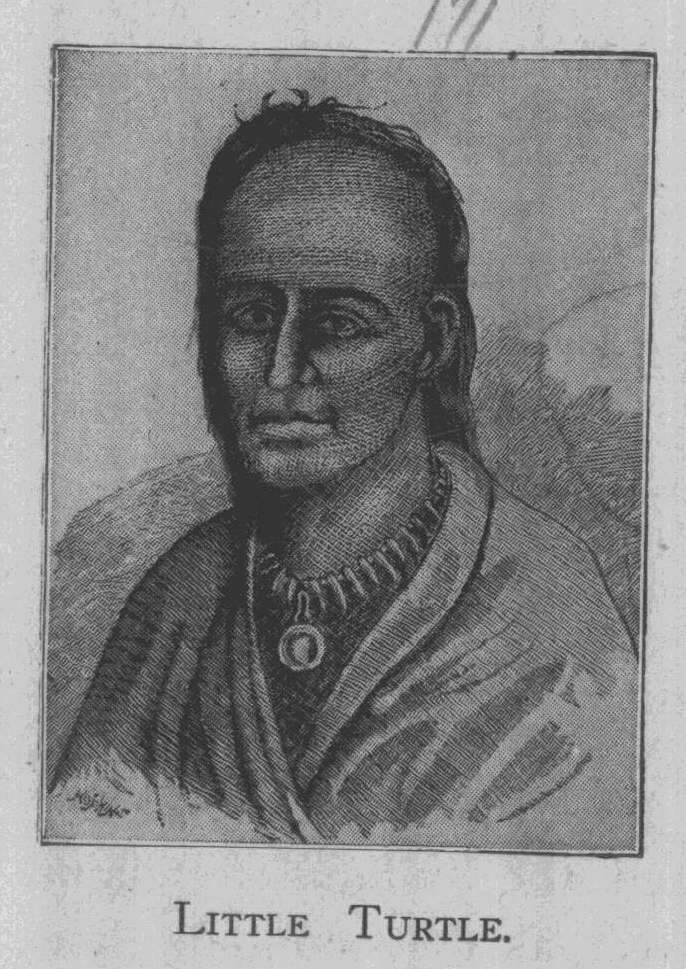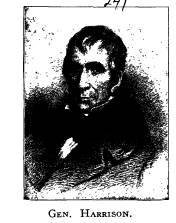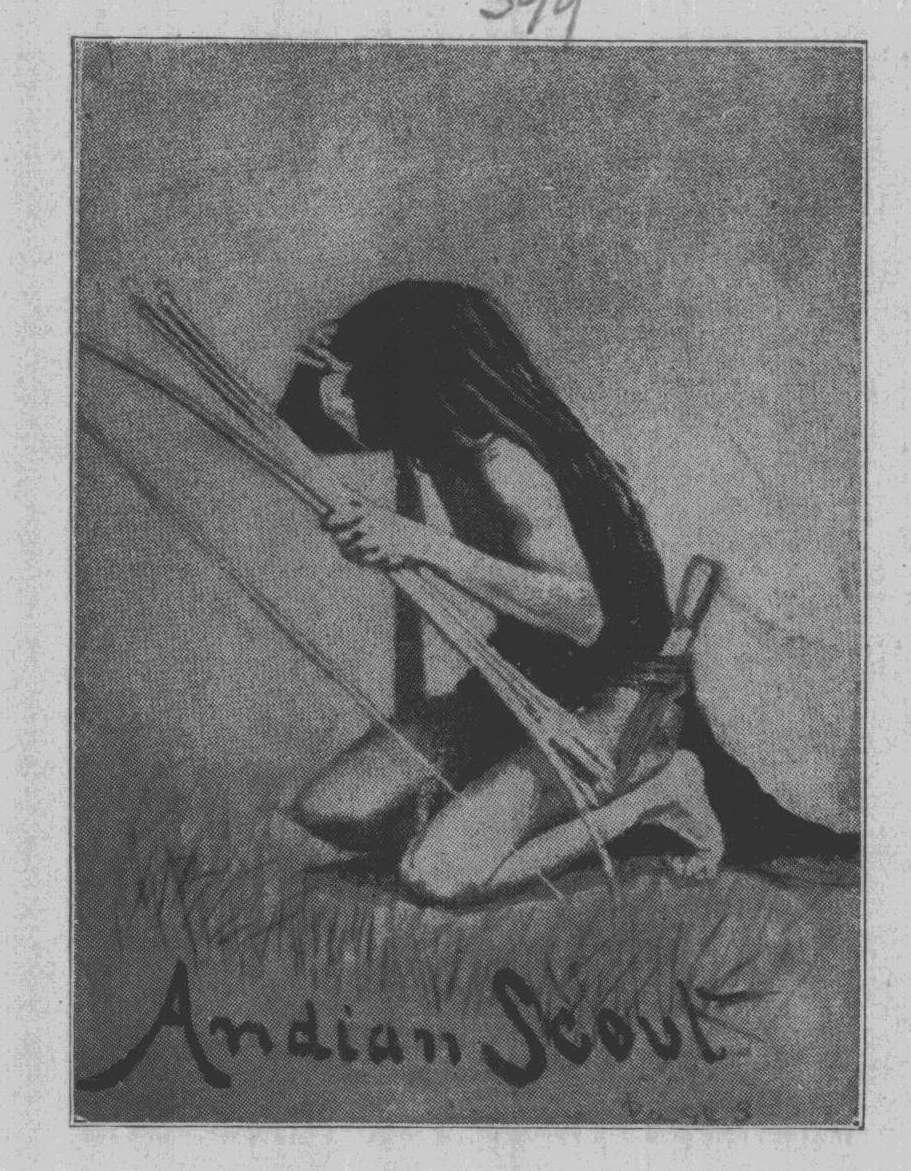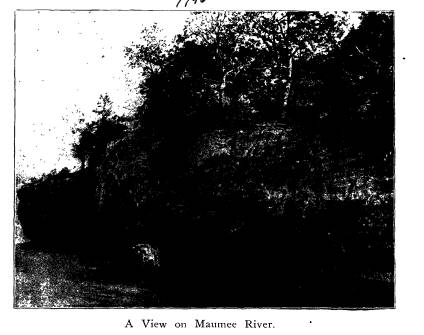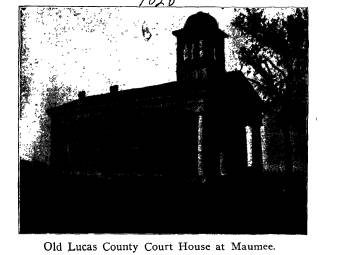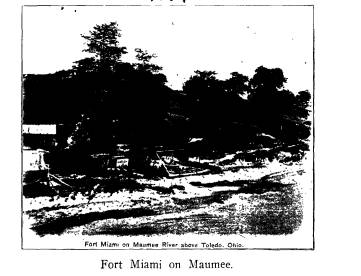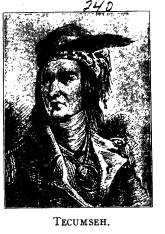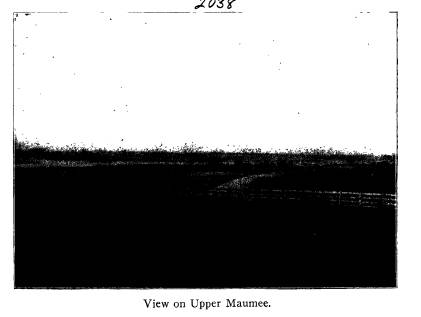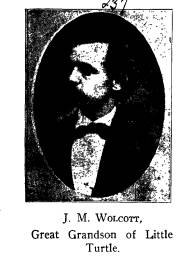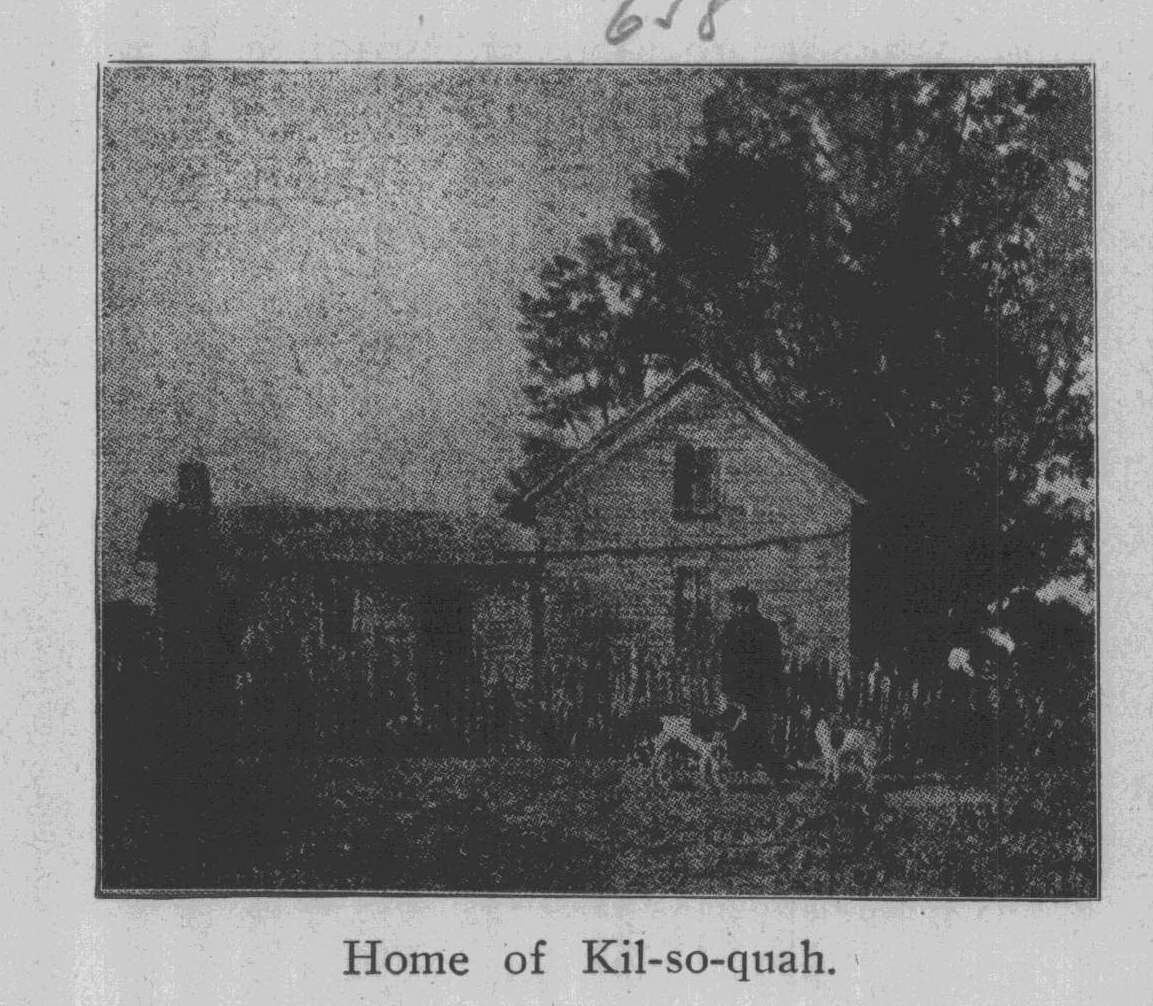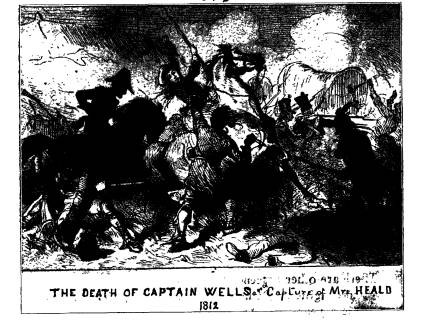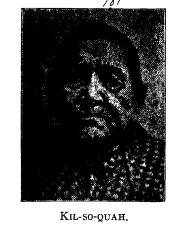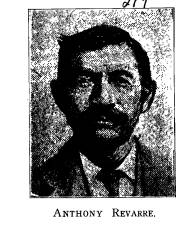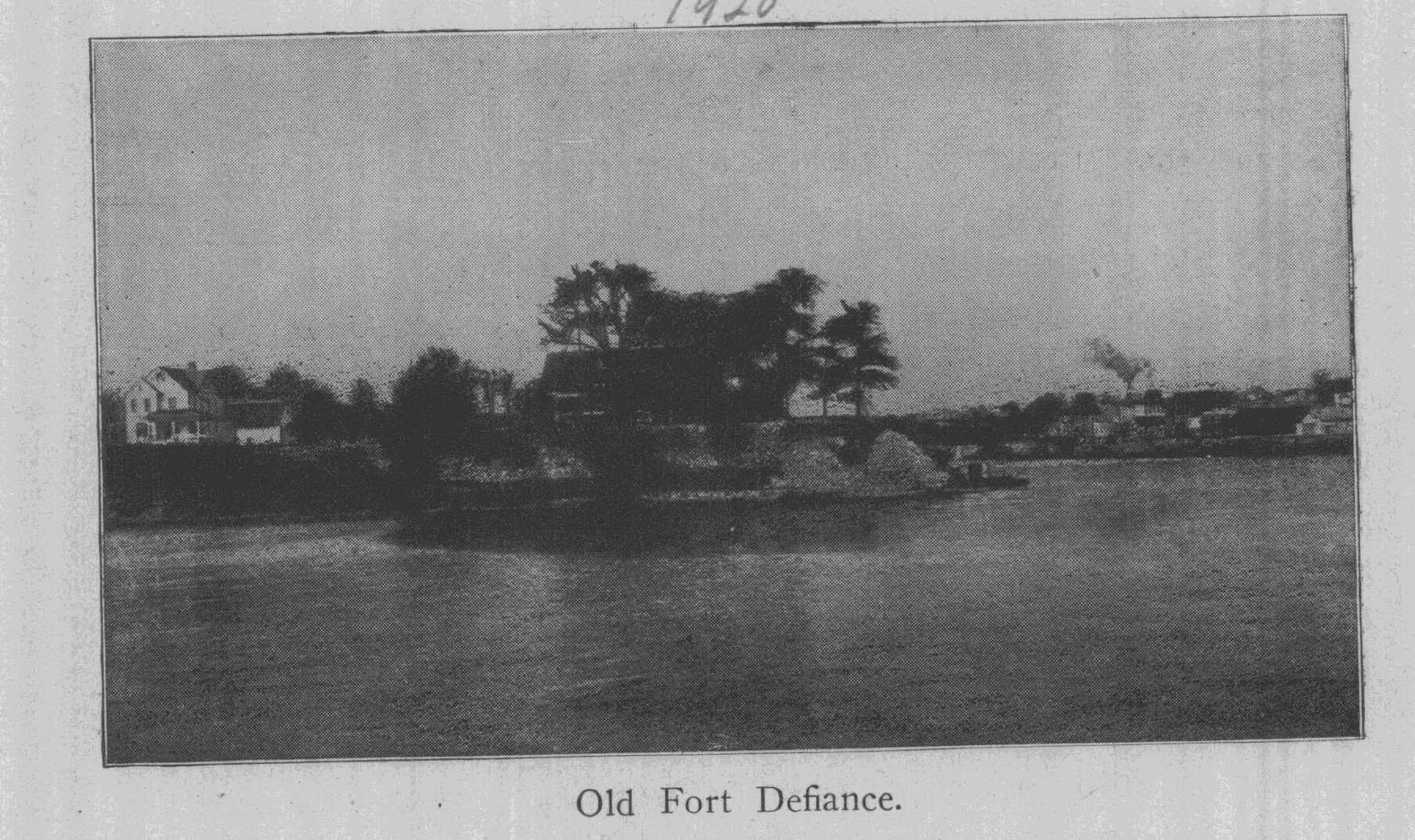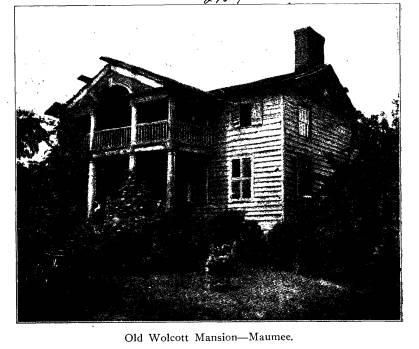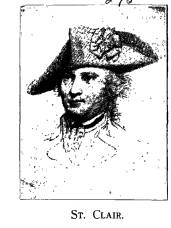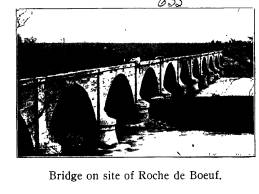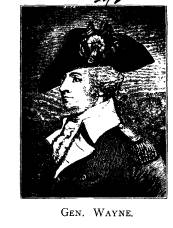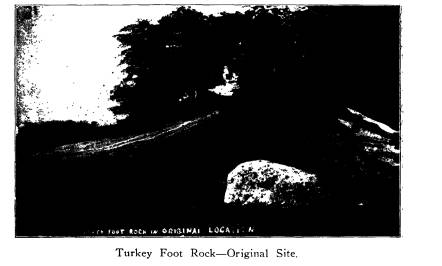Ohio History Journal
|
ME -SHE -KUN-NOGH -QUAH, OR LITTLE TURTLE-1783-1812.
N. B. C. LOVE, D. D. O River, weird historic water, What tales of bloody human slaughter What scenes of hate, and tragic acts, What woeful pictures, solemn facts, Thou couldst before the world portray! What greed and hate and wrong betray! No subject claimed the attention of President Washington more after the close of the War of the Revolution 1784 up to his death 1799, than the settlement |
|
and occupancy of the territory ceded to the United States by England. With that part of this territory known as the Northwest, we are es- pecially interested in when writing of the life of Little Turtle, the great Miami Chief. The scenes of his life are located here. The territory known as the Maumee Basin, includes Northwestern Ohio, Southern Michi- gan and Northwestern Indiana. At the ending of the 18th Century and the beginning of the 19th, it was a region of vast natural resources. Its fertile soil, and natural drainage by |
|
|
creeks and rivers, into the lakes, made it productive of vast for- ests, wide prairies covered with nutritious grass, and valleys pro- ducing, with little cultivation, immense crops. The streams and lakes abounded in choice fish, and the forests in wild animals in great variety and numbers. Wild nuts and fruits were plentiful and could be laid by in store for winter use. 115 |
|
116 Ohio Arch. and Hist. Society Publications.
The Indians raised large quantities of corn, pumpkins and beans. General Wayne reports continuous fields of corn along the Auglaize, Maumee and St. Joseph rivers. Huts of bark and poles were easily made, the bark of the elm being a substitute for shingles and boards. The skins of animals furnished clothing and bedding. Large trees were shaped into canoes and pirogues. After the French Traders penetrated these wilds the In- dians sold them choice furs, taking in return trinkets, vessels for cooking, axes, tomahawks, knives, guns and ammunition. Also cotton and woolen goods for clothing. The French and other trading posts were mostly on navi- gable streams, that is to the canoe and larger craft. Unfortunately, rum was a standard article of trade. The Spanish, French, Dutch, English and American traders were |
|
|
alike guilty, and then as now was a prime cause of blood shedding and savagery. At the close of the War of the Revolution the English continued to encourage the Indians in their hostili- ties against the American settlers. Gen. W. H. Harrison, who was a member of Gen. Wayne's Staff, and Commander of the American Army in 1812-1814, witnesses to this effect, but indeed we know of no historian who denies it. And up to 1795 the English urged the Indians to claim the Ohio River as the boundary line |
|
between them and the United States, which they perseveringly did up to 1795. During the seven years' war with England the Indians gen- erally sided with that government. Of course, the borders of the United States suffered greatly from the savage attacks. The backwoodsmen were not slow at retaliation, and engaged some- times in the promiscuous killing of Indians, men, women and children, and how dreadful for men calling themselves Chris- |
Me-she-kun-nogh-quah, or Little
Turtle. 117
tians to be perpetrators of foul
murders, as the killing of Chief
Logan's family simply because they were
Indians, and the large
number of Christian Indians at the
Moravian Mission at Gnad-
enhutten!
Indians from birth were taught to
cruelty and bloody re-
venge, but not so the whites. The
Americans as a people de-
plored this at the time. The Indians
were, as they understood
it, fighting for their homes. Many of
the great chieftains de-
plored the killing of captives, and
women and children. Little
Turtle, Blue Jacket, Tecumseh,
Buck-on-ge-ha-las and Tarhe
were of the number. Among the white
frontier squatters were
men very ignorant, children or
grand-children of criminals, im-
ported to this country from Europe,
charged with crimes, and
thus by heredity as well as environment,
were ready when op-
portunity came to perform deeds of
barbarism. Of course there
were Indians who, too, were
blood-thirsty by inheritance, and
their sense of pity undeveloped.
The following named tribes lived in the
great Maumee basin
during the Indian war period, 1783-1812: Wyandots,
Delawares,
Shawnees, Miamis, Ottawas, Chippewas,
Pottowatomies, Kicka-
poos, Weas, Pinkeshanes, and Kaskaskias,
and some smaller
tribes.
One of the many evidences of the good
intentions of Presi-
dent Washington and Congress toward the
Indians was the
granting two of the first named tribes a
thousand dollars each,
paid them in goods, and the other five
hundred paid in the same
way, and this to be continued annually.
The goods to be val-
ued at cost and first prices. Large
portions of land were to be
held by them. Many other favors by him
were proposed. One
was that of hunting on ceded lands, and
they had authority to
arrest and report trespassers.
These conditions of peace were not fully
endorsed by the
Indians until the treaty of Greenville,
when in substance they
were agreed to.
The treaty of Paris seemed to be the end
of war between
England and America, but it soon was
evident England did not
mean to keep it. The boundary line was
to be a central line
through the middle of the Great Lakes,
and the Western bound-
|
118 Ohio Arch. and Hist. Society Publications.
ary the Mississippi River, but notwithstanding, the British did not surrender the fortified posts along the chain of the lakes from Niagara to Mackinac. The British were strong, and we were weak, and had to, for the time, consent tacitly. For 15 years this violation of the treaty existed, and all this time the unsurrendered posts were the rallying points of the Indian Tribes; receiving their furs and other articles of trade, giving in return clothes, utensils, guns, knives, tomahawks and ammuni- tion. The emissaries of England had helped to formulate the |
|
|
thoughts in the Eastern States of opposition to the expansion of the government throughout the West. They said the West and Northwest were not worth what it would cost to make them inhabit- able. When in 1790 Washing- ton issued a call for volun- teers but few responded, and men were drafted in New York and Pennsylvania for St. Clair's army. England set up the ex- cuse for continued violation of the treaty that the Ameri- cans had not kept good the |
|
treaty of 1784 by making good certain losses claimed by English- men. This territory was organized as the "Northwest Terri- tory" in 1787 with Gen. Arthur St. Clair as Governor. Emigration set in from the east. Settlements sprung into existence. Marietta and Cincinnati were founded. Lands were surveyed, granted to companies and purchased. The Indians became enraged; their hunting grounds were invaded. Some- thing had to be done. The Indians could count on compara- tively a large army of brave trained marksmen as soldiers, with the source of supplies in the English Forts. Savages foraged the borders of civilization to kill, plunder and burn. St. Clair |
Me-she-kun-nogh-quah, or Little
Turtle. 119
called on Congress for help. Washington
endorsed the call
and recommended Gen. Harrison as
commander. The army
was organized.
LITTLE TURTLE.
Say not that those who chased the game
O'er hillsides and o'er plains,
For border wars were alone to blame,
And white hands free from stains.
Little Turtle was the head and war chief
of the Miamis,
and in 1790, and on until after the Peace
Treaty of Greenville
in 1795, the leader of the confederate
forces of the Indians of
the North West Territory.
He, by his harassing of the white
settlers by frequent in-
roads with small bands was hardly known,
but in 179O he ap-
peared as the leading commander of the
Indian forces.
Little Turtle's father was also head
chief of the Miamis.
In 1760 he with the war chiefs of the six
nations was invited by
Gen. George Washington to meet him in
Philadelphia, Pa.,
which they did, and there adjusted some
difficulties between
them and the Colonial government. The
name of this chief was
Ke-qun-ac-quah. Washington gave him a
parchment with an
inscription burned on it, expressive of
good will toward the
Miamis. We have in history no other
mention of this chief.
The Miamis during the period of which we
write, I783-
1812, occupied the upper Maumee Valley
and in part the Wa-
bash.
Not far from the site of Fort Wayne,
Little Turtle was
born. Of course he was in evidence when
a boy and young man.
His associations were with the French
and English Traders as
well as with the Indians. He by some
means had learned the
arts of European war. He tells that when
a young man he ex-
celled in manufacturing Indian war
implements. He became
head chief of his tribe while a young
man.
In one of his expeditions into Kentucky
he captured a boy
about eleven years old, by the name of
William Wells, and after
a time, when married, he adopted him as
a son.
Wells belonged to a good Kentucky
family. While he
|
120 Ohio Arch. and Hist. Society Publications.
adopted Indian life readily, yet his blood told, for he was un- like the Girtys, and Magee and other renegade white men, who, no doubt, had inherited vile traits from their low down and ignorant parents. As Wells grew up to manhood he won the esteem and affection of Little Turtle and wife. In time he won and married his adopted sister, Little Turtle's beautiful daugh- ter, and thus Wells became in fact the son-in-law of Little Tur- tle. He and his foster father became life-long friends. |
|
|
|
Wells took a prominent part in the campaign against Har- mar and St. Clair, and rendered valuable services. Also in the Chief's associations with the English he was principal inter- preter. On the eve of the Battle of the Rapids, or "Fallen Tim- bers," Captain Wells was satisfied from what he had learned of the feeling of the American Government, the ability of Gen. Wayne as a Commander, and the large and well organized army |
Me-she-kun-nogh-quah, or Little
Turtle. 121
under him, that defeat of the
confederated Indian army was
certain if a battle were fought.
Therefore he had advised peace,
and had proposed to unite with the
Americans. Little Turtle
was of the same mind.
Wells on a beautiful afternoon invited
Little Turtle to take
a stroll with him, and they passed
together to a promontory on
the Maumee, from which up and clown the
river the picturesque
scenery could be seen in all its
midsummer glory. There he
broke the news of his purpose to him,
saying, "My father, we
have long been friends, but I now must
leave you to return to
my people, and we will remain friends
until the sun reaches its
midday height, and from that time on we
will be enemies, and
if you wish to kill me you may, and if I
wish to kill you I may."
They warmly embraced each other, and the
large tears
coursed down the sun-bronzed cheeks of
the chieftain, who was
unused to manifesting emotion. Both felt
deeply as they sep-
arated. Each had his work to do, and
there was no escape ex-
cept by performance. And what they
afterwards respectively
did helped to shape the destiny of the
American Nation, as well
as favoring the Indians, who were
finally led to see that antag-
onizing the extension of it was to wipe
out the Indian tribes.
Little Turtle was more than ever
convinced of the futility
of war, but to be consistent he felt he
must act with the Indians,
so as not lose his influence over them.
In this he evinced the
greatness of his character. He would
sooner take all the
chances of disaster than seem to be
untrue to his people. In the
last council before the Battle of the
Rapids he stood for armis-
tice, for one more effort for peace,
for, as he said, he saw fear-
ful disaster if they ventured a battle.
And further said: "We
have beaten the enemy twice under
different commanders. We
cannot expect the same good fortune
always to attend us. The
Americans are now led by a chief who
never sleeps. The night
and the day are alike to him. During all
the time he has been
marching on our villages.
Notwithstanding the watchfulness of
our young men we have never been able to
surprise him. Think
well of it. There is something whispers
in my mind it would
be well to listen to his offers of
peace." Blue Jacket, and other
chiefs were for the battle. Little
Turtle then suggested a plan
|
122 Ohio Arch. and Hist. Society Publications.
that would, he thought, end in victory: it was with a part of the Indian army to hold Wayne in check, but fall back. Let a large part of the army that night quietly ford the river and make forced marches for the rear and deposit of supplies. Then join the army on the north side again. To all Little Turtle proposed Blue Jacket vehemently objected, even calling Little Turtle a coward. Little Turtle in his reserved but concise way only replied: "Follow me!" Of the battle the next day we shall speak later. The plan of the fight for the next day was all arranged that night. Little |
|
|
|
Turtle was in command. One authority that we know of, among the older historians, says that Blue Jacket was in com- mand. Another says Brant was, but all others say Little Turtle was the Commander-in-Chief. Little Turtle accepted Wayne's offer of peace after the bat- tle, and the Indians' defeat. He was among the first. Wells' knowledge of him, and confidence in him, and Wayne's knowl- edge of Wells and his bravery and loyalty, were in Little Tur- tle's favor, and his brave effort in the Battle of the Rapids, gave him credit with the Indians. In the part he took at the Treaty of Greenville, he was second to none. While he hesitatingly |
Me-she-kun-nogh-quah, or Little
Turtle. 123
made concessions to Wayne, yet he was
slow to accede to the
proposition to make the treaty ceding
away to the Americans all
the North West Territory, but finally
consented, but wanted a
lasting peace. Tarhe, The Crane, a great Wyandot chief, took
the same position. Finally all the
representatives of the tribes
fell in line. Tecumseh, chief of the
Shawnees, refused to sign
the treaty, but other representatives of
his tribe did sign. Te-
cumseh fought valiantly at Fallen
Timbers.
A careful study of the leading minds
among the Indian
chieftains, we find that there were none
in real statesmanship
superior to Little Turtle, and in clear
discernment of the rela-
tions of the Americans and Indians he
stood foremost.
Be it to the credit of the chiefs of
this treaty that all who
signed it never rescinded their action.
Although when the war
of 1812 was on, Little Turtle died, yet
he had the desire to do
service for the American Government. He
was loyal to the last.
Tarhe, the Wyandot chief, an old man
more than seventy,
at Gen. Harrison's request, went at the
head of his Wyandot
warriors to see a part of the tribe in
Canada to have them side
with the Americans.
Some of the younger chieftains of the
treaty of 1795 took
an active part for our country in the
War of 1812.
Mr. Mansfield, when a boy, 1798, saw
Little Turtle at Cum-
minsville, Cincinnati, he says:
"One day a dark man with swarthy
countenance, riding a
very fine horse, dismounted at our house
and went into my
father's office. I wanted to go in and
see him, but for some rea-
son I was not permitted. After some time
I saw him come out
and mount his horse and rapidly ride
away. I was struck with
the appearance of the man and said, who
is that, Ma? She said
it was Little Turtle, the Great
Indian Chief."
Col. John Johnson, Indian Agent, in his
personal recollec-
tions published many years ago, says:
"Little Turtle was a
man of great wit, humor and vivacity, fond
of the company of
gentlemen, and delighted in good eating.
This great chief died
in 1812. He was buried with military
honors by the troops of
the United States. He used to entertain
us with war stories
|
124 Ohio Arch. and Hist. Society Publications.
and adventures, and would laugh heartily with us at the recital of them." He said a Kentuckian, a prisoner of the Miamis for some years, had sought permission to accompany a raiding war party but was refused, but' at last he gained the opportunity, and went in a company commanded by Little Turtle. Reaching the bor- der of a settlement in Kentucky, in the early hours of the morn- ing they stealthily approached a large hewed log house occupied by a number of Americans. A11 was quiet and the Indians were crawling on their hands and knees, and the Kentuckian, ahead |
|
|
|
of the rest, when he suddenly arose and shouting, "Indians! In- dians!" ran into the house, while the Indians retreated. From that day on Little Turtle never trusted a white man in conflict with his own people. He was a generous and humane chief. Schoolcraft, the historian, says: "He was alike courageous and humane, pos- sessing great wisdom. There have been few individuals among the aborigines that have done so much to abolish the rites of human sacrifice. The grave of this noted warrior is shown to visitors near Ft. Wayne. It is frequently visited by Indians in |
Me-she-kun-nogh-quah;
or Little Turtle. 125
this part of the country, by whom his
memory is cherished, with
greatest respect and veneration. He was
opposed to burning
captives and did much to abolish the
practice. After the peace
of 1795 he devoted much of his time in
trying to improve the
condition of the Indians and encouraged
them in efforts at civ-
ilization. He went east, visiting
Philadelphia and other cities,
dressed in American costume. He met
Volney in that city and
with him had a long interview which is
recorded. Among many
things said by the French writer was,
"Do you not think that
the Indians descended from the
Tartars?" Little Turtle re-
plied: "Why not think the Tartars
descended from the Indians
if they look so much alike?"
Little Turtle had the honor of visiting
the President Wash-
ington, and never forgot the kindness
shown him by "The Great
Father."
While east, in Philadelphia, he met the
great Kosciusko, the
Polish patriot, who presented him with a
brace of valuable pis-
tols he had used in contests in Poland.
They were prized highly
by Little Turtle.
It is said of Little Turtle that he
never was intoxicated,
and did all he could to keep his people
from drink. He urged
his Indians to avoid it and set them a
good example. This can-
not be said of Gen. Harmar, who on
September 3rd, 1790, was
remonstrated with by Secretary of War
Knox, for drunkenness.
His defeat may have been in some measure
attributed to his
drunkenness.
Rum, alas, was sold to the Indians by
Spaniards, French,
Dutch, English and Americans, and many
of the most cruel
deeds were intensified by it, whether
perpetrated by red or white
men. The great wonder is that greater
injury was not done by
drunken backwoodsmen, and the Indians
when under its influ-
ence.
The moderate use of liquors was thought
right and impor-
tant in the early American armies. Gen.
Wayne in his journal
complains bitterly of the small amounts
of liquor sent to him
to give as part of the daily rations. As
an article of traffic there
was no depreciation of its value. The
loneliness of the sick or
126
Ohio Arch. and Hist. Society Publications.
wounded soldier was driven away by its
use, so thought the
commanders of that day.
More battles were fought, more people
were killed, more
peace councils held in the Maumee
Valley, from the time of the
French occupancy up to 1795 than
elsewhere in the great Cen-
tral West and Northwest. The history of
the Indian Councils
held, and of the treaties signed, would
make a large volume.
And from 1783 on to the death of the
"Father of his country,"
it was his continual desire to protect
and treat justly the Indians.
To this end did Washington time and
again instruct special
agents sent to the Indians, and the
Generals in command of the
armies, not only to protect the border
citizens, but urge them
to seek the good will of the Indians.
Especially did he, through
Gen. Wayne, try to negotiate peace and
secure a better under-
standing with them. In this work the aid
of the Chieftain Brant
was sought, but declined, and after the
defeat of the Indians at
the Rapids Little Turtle was much in
evidence as the friend of
peace and fair adjustment of all
difficulties without shedding of
blood.
During all this period the British were
active sowing the
seeds of discord among the tribes, and
giving encouragement
and sanction to the murderous attacks
upon the American fron-
tiersmen.
After the great defeat in 1794 Tecumseh,
entering into ma-
ture manhood, and being the inveterate
foe of the Americans,
commenced an aggressive career, which
only ended with his
death at the Battle of the Thames in
1813.
Sir John Johnson, the representative of
the English in
Canada, wanted the border wars to
continue, so the emigrants of
the colonies instead of going westward
would go to Canada.
All these efforts of the British and the
Indians under their
influence were contrary to the Treaty of
Paris 1784. Generals
Harmar, St. Clair and Wayne were under
instructions from the
President to exhaust all their resources
in repeated endeavors
for peace.
In 1798 Washington employed Antoine
Gamelin, of Vin-
cennes, who was commissioned by Major
John Hamptramck, to
visit and conciliate the Indians of the
Northwest, but he was un-
|
Me-she-kun-nogh-quah, or Little Turtle. 127
successful. He had hardly returned from his trip when word came that an American captive had been roasted and eaten by the Indians at the headwaters of the Maumee. Also that all the Indian Tribes had sent war parties to massacre the invaders of Indian territories, and even to attack settlements south and east of the Ohio. This threw a damper upon peace efforts, and the border whites under Generals Scott and Wilkinson, and others, paid the Indians back in their own coin. During this period Little Turtle was a recognized leader and adviser in war movements among the aborigines. After the |
|
Treaty of Greenville, border wars ceased until Tecumseh and his brother undertook the formation of an Indian confederacy to drive the white men back. His plans em- braced a battle line of a thousand miles, extending from the Lakes of the North to the Gulf. It was largely a failure. The distance was too great and communication too slow. His brother, The Prophet, precipitated the war in 1811. Har- rison defeated him at Tippecanoe, Indiana. The influence of Little Turtle and other prominent chief- |
|
|
tains were against this war. They had not forgotten Wayne's victory. We must not forget the fact that the Indian Tribes as such, were divided in their adherence to the whites. The largest num- ber were for peace, and were true to the American Government. These "friendly Indians" Harrison trusted and controlled dur- ing peace, before the war of 1812, and during the war, and after- wards. The others, who had been inspired by Brant and Blue Jacket to hate the Americans, had a fitting successor in the brave ardent Tecumseh, who was idolized by his braves, petted and liberally paid by the English. Of him we need not write. His complete life has been written at different times and authors, |
|
128 Ohio Arch. and Hist. Society Publications.
and fully portrayed by the historians of the last century and the present. In each battle in which he fought he holds in the his- torical records a more prominent place than any other Indian chieftain. The same is true as to the treaty councils in which he figured. He was an orator, and dressed up to the highest con- ception of the Indian thought of great magnificence; at times wearing the costume of an English Brigadier General. Nor did any white general of His Majesty's army look more imposing. He was spectacular and yet great, a natural leader of men. |
|
|
|
Little Turtle, we think, was a greater chieftain than Te- cumseh. The latter was more imposing in appearance. Little Turtle was six feet high, but slender and muscular and not fleshy. Tecumseh evinced upon his countenance his emotions. Not so Little Turtle. He could smile and yet feel angry. He was said to be cunning, but was simply a diplomat. He had com- plete control of himself at all times. He was able, fluent, earn- est, logical and consecutive in his speeches. |
Me-she-kun-nogh-quah, or Little
Turtle. 129
Tecumseh undertook establishing a
confederacy of all the
Indian tribes of the South, West, and
North, and East of the
Mississippi, but failed.
Little Turtle, aided by Blue Jacket and
Buch-on-ge-ha-las,
undertook to confederate the tribes of
the Northwest Territory,
and succeeded.
Tecumseh never gained a great battle,
but Little Turtle
gained two complete victories over two
great armies and their
ablest generals. Back of these generals
and armies was the
great General Washington, and the great
War Secretary Knox.
The President was surprised at the
defeat of his armies
under Harmar and St. Clair. Both these
generals were retired
in turn after their defeat. They had
proven themselves able
and worthy in the War of the Revolution,
and Washington had
the utmost confidence in them. He did
not know of Little Tur-
tle and his ability. He called upon
"Mad" Anthony Wayne to
raise an army, and to well organize and
equip it before he ven-
tured into the Indian country. He told
him not to underesti-
mate the power of the Indians now elated
with victory, and to
beware of surprises. He knew that the leaders of the western
Indian army were crafty and had
generalship.
E. D. Mansfield, in his personal memoirs
published in 1879,
says: "The figure that stands out
on the historical canvas in
bold relief is Me-she-kun-nogh-qua, the
Little Turtle Chief of
the Miamis." We could give other
statements concerning his
pre-eminence but space forbids.
Little Turtle foresaw the victory of
Wayne, but all the
chiefs, young and old, were against him.
Tecumseh, although
young, must have been of the opposing
number.
After defeat he was the first chieftain
to surrender of his
own mind and enter into an effort for a
general peace confer-
ence. He saw the only hope of the
American Indian was the
triumph of the American government.
Tecumseh believed that ultimate victory
would be with
England.
Little Turtle, in the vision of
prophecy, saw the American
Eagle soaring on this continent over the
English Lion. He,
like our great President, was first in
peace, and first in war. He
Vol. XVIII-9.
|
180 Ohio Arch. and Hist. Society Publications.
established a home, a permanent home, on the Maumee near Ft. Wayne, and there attempted a civilized life, planting a field and rearing domestic animals, but his wild Indian neighbors killed his animals and tried to make life unpleasant, yet in his retire- ment he was respected by Indians and white men, the English and French being among the number. Tecumseh delighted in war, and brave chieftain as he was, died in the front of the battle. It is said by only one writer we have consulted that Little Turtle had at the same time two wives, one about 50 and the other 18. This was about 1807. Let this be as it may, he was a heathen, and had not been the subject of missionary instruc- tion. The writer thinks the historian that made this statement |
|
was misinformed. Mr. Wolcott had never heard of it. Little Turtle's grand-daughter, now 98, says noth- ing about it. The money given him for ser- vices, and the large quantity of land, by Congress, made him comfortable. He had a good plain building fur- nished up to pioneer style, and a farm cultivated so that he had bread and meat. Mr. J. M. Wolcott is the last de- scendant of the great chieftain in the lower Maumee. It is claimed by one history of the Maumee Valley that there are several people descend- ants of his about Ft. Wayne, other |
|
than the old lady, Kill-so-quah. Mr. Wolcott is married but has no children. He has been recently Mayor of Maumee City, and for several years Trustee of the Maumee Memorial Association, through which the grand granite monument now stands on old Fort Meigs, at an expense of $25,000, besides what was paid for thirty-five acres including the Fort. The monument and all the land was paid for by the State, excepting eight acres paid for by the Association. |
|
|
|
Me-she-kun-nogh-quah, or Little Turtle. 131
Mr. Wolcott is satisfied that he, as a direct and legal heir, is entitled to a large tract of land near Ft. Wayne. Mr. Wol- cott has a Government Patent that was issued for the land, and upon record at Washington, discovered by his attorney, Hon. Gen. I. R. Sherwood, member of Congress from the Ninth Ohio District. The suit is pending and will no doubt, to a great ex- tent, be in favor of Mr. Wolcott. Gen. Sherwood also found an old affidavit given by Gen. John E. Hunt, who located in Maumee in 1815. He was a Major General and Commander at the time of his death, of the 18th Division of the Ohio militia. The writer knew Gen. Hunt, and he was an honest reliable |
|
man. The historical account he gives of Little Turtle and family he swore to before Mr. D. R. Austin, notary public, in and for the County of Lucas, the 29th day of October, 1870. It was witnessed by Victor Keen, clerk of the Court of Com- mon Pleas. Gen. Hunt was only about nine or ten years of age when he had |
|
|
knowledge of the things he swore to in 1870. We knew him in 1870 and he was in his right mind then. In 1807 General Hunt resided in Ft. Wayne, Indiana, and during his residence became well acquainted with the celebrated Indian Chief, Little Turtle, of the Miami Tribe of Indians, whose name was Me-she-kun-nogh-quah. General Hunt, up to his death knew the living members of Little Turtle's family. Little Turtle had an adopted son, William Wells, who was after- wards killed at the Indian massacre at Chicago in 1812. Wells married the daughter of Little Turtle, whose name was Wan- mau-ga-pith, or Sweet Breeze. |
132 Ohio Arch. and Hist.
Society Publications.
The following is the chronological table
as given and sworn
to by Gen. Hunt:
CAPTAIN WILLIAM WELLS (Wau-mau-goh-pith).
Children: -
Ann Wells, or Au-piz-a-quah
Married Mr. Turner.
Rebecca Wells, or Tes-ma-soh-quh
Married Hackley.
Mary Wells, or Au-mau-quah-zah-quah
Married Judge James Wolcott.
William Wayne Wells, or Wau-me-mor-gah
Who died August 1832, without marriage.
Mary Wells and James Wolcott resided in
Maumee City
1828. Mary Wolcott died at Maumee 1843.
Was well ac-
quainted with her and her family during
the time of her resi-
dence here.
By her husband she had the following
children, towit:
Mary Ann Wolcott, 1848, married Smith
Gilbert.
Henry C. Wolcott. Dead since.
Fredrick A. Wolcott. Killed in Rebellion
1864.
James M. Wolcott. Resides in Maumee
City. Has no children.
List of Smith Gilbert's children living
in Maumee in 1870:
Fredrick E. Gilbert,
Albert W. Gilbert,
Smith W. Gilbert.
Captain William Wells did grand service
as an Indian scout
for Wayne in his campaigns and battles
with the Indians. He
was true to Wayne, as he had been to the
Indians. After the
battle he did much to induce the Indians
to make peace with
Wayne, and he was the friend of every
Indian who was for
peace. The high esteem in which he was
held by Wayne was a
great help to his father-in-law, Little
Turtle, who had surren-
dered. For the years between 1795 and
1812 he lived a neigh-
bor of Little Turtle near Ft. Wayne. He
was a sober, honest,
loyal citizen, respected by the
Americans and Indians. He had,
about 1812, gone to Ft. Dearborn,
Chicago. Mrs. Held, the
wife of the Commander at Ft. Dearborn at
this time, was the
|
Me-she-kun-nogh-quah, or Little Turtle. 133
daughter of Col. Samuel Wells, brother of Captain William Wells. Col. Wells was in the American Army under Wayne. Cap- tain Held was in charge of Ft. Dearborn, where Chicago now stands. He was advised by a friendly chief, Win-ni-mac, to evacuate and go to Ft. Wayne. William Wells, with twelve men, had been sent to assist in the retreat. The head chief of the Pottawatomies, the tribe in that locality, was a bitter enemy |
|
|
|
of Captain Wells. His name was Black Bird. His coming ex- asperated him. Col. John Johnson says, that he had often spoken of Wells to him in the most bitter terms. Johnson had been agent there. On the 14th of August a council was held between the officers and chiefs, and agreed that the whole gar- rison with their arms and ammunition sufficient for the journey, and clothing, retire unmolested to Ft. Wayne, and the garrison and all it contained should be delivered up to the Indians. The night preceding the evacuation all the powder and whiskey were |
134
Ohio Arch. and Hist. Society Publications.
thrown into the canal leading from the
garrison to the Chicago
river. The powder floated out and
revealed the deception to
the Indians. This exasperated them and
brought matters to a
crisis. The 15th of August the troops
marched out to commence
their journey, and had gone but a short
distance when they were
attacked by the Indians. Wells, seeing
all was lost, and not
wishing to fall into their hands, as he
knew in that case a lin-
gering and painful death awaited him,
wetted powder and black-
ened his face as a token of defiance,
and commenced addressing
the Indians in opprobrious and insulting
language he could
think of. His purpose was to have them
dispatch him forth-
with. His object was accomplished as
they became so enraged
with his taunts and jeers that one of
them shot him off his
horse, and immediately pouncing upon him
cut his body open,
took out his heart and ate it. Most of
the troops were massa-
cred. The commanding officer and wife
were saved. Mrs.
Held fought bravely, but was made
prisoner with her husband.
Another account states that the most of
the women and
children were murdered. Twelve little
children sheltered in a
wagon were tomahawked. It was said by
historians that Te-
cumseh had much to do with intensifying
the hatred of the
Pottawatomies against the garrison.
Little Turtle's death was in his own
home about the same
time.
* * * * *
There are other descendants of Little
Turtle. One of these
is a grand-daughter. Of her we learned
in an article in the To-
ledo Blade a year since, by H. L. Askew,
Blade correspondent.
We quote from this article the following
in substance:
Her name is Kil-so-quh. She is now 98
years of age. Her
home is near Roanoke, Ind., 16 miles
west on a few acres of the
original reservation. Only a short time
ago she posed for a
photo at the request of the Blade
reporter which is here repro-
duced. She is the last of the full
blooded Miamis. She was
born in the month of May, 1810. Her
birthplace was an island
at the forks of the Wabash River just
west of the present city
of Huntington, Ind., and the tract is
now known as Miami Park.
|
Me-she-kun-nogh-quah, or Little Turtle. 135
Her mother was one of the best Miami maidens. The land she lived on was given her by her mother, who received it from her father, a chief, Wak-shin-gah, who gave land in Ohio for it. In 1830 Kilsoquah became the bride of a Miami, John Owl, but he soon died, and a few years later the grand-daughter of the great chief married Anthony Revarre, a half-blood Indian who was known as Shoop-in-au-wah, or Thunder Storm. Re- varre died in 1849, and his remains are buried on the Reserva- tion. Here was an Indian burying ground, but all has been plowed over and the location of the graves lost. Her son, An- thony Revarre, is now fifty-nine years old, and has charge of the |
|
little farm, and provides well for his royal mother, Kill-so-quah. He speaks English well and has a com- mon English education. Her husband and she lived in a log house, but long ago it burned and was replaced by the little frame building now standing. Kill-so-quah a few years ago, after much entreaty, attended a pio- neer meeting at Ft. Wayne, and en- joyed it. Still later, going in an au- tomobile, she attended one at Co- lumbia City. She was carried to and fro in charge of a committee, her son |
|
|
enjoying her honors. It was a great treat on both occasions to the almost centenarian, the last full-blooded Indian of the North- west Territory living in the Wabash and Maumee Valleys; and no less a pleasure to the thousands who gazed upon her. She is a large fleshy woman and walks with difficulty. Ex- cepting the infirmities of age she has never been sick. She, like most Indians of the Valley, has been an immune to malaria. She lived close to Nature, and Nature has been a kind mother to her. Her knowledge of Christianity is limited, but she trusts in the Great Spirit. Living up to the best light received, she is look- ing for the "Happy Hunting Grounds" of her forefathers. |
|
136 Ohio Arch. and Hist. Society Publications.
LE BALM'S ADVENTURE AND LITTLE TURTLE'S FIRST BATTLE. In 1760 the English captured from the French Ft. Miami at the confluence of the St. Joseph and St. Mary's rivers. The French had held it for fifty years. Three years afterwards Pontiac took it from the English and the Indians held the posi- tion for thirty years. During this period it was the scene of savage and barbarous government. The glory and power of the Miamis was unchecked until the advent of Wayne. In 1780 a Frenchman living at Vincennes, conceived the idea of the surprise and capture of Detroit, which was held by |
|
the English. Vincennes was then under American rule. Three years before the intrepid George Rogers Clark had captured this place from the British without firing a gun or shedding blood. No doubt this gave the thought to Le Balm, a wealthy Frenchman, of undertaking the sur- prise and capture of Detroit. His motive was plunder, but his pretext was to aid the Americans in their struggle for liberty. Le Balm quiet- ly enlisted a hundred men, mostly Frenchmen. Two French traders took stock in the enterprise furnish- |
|
|
ing the sinews of war, money, arms and ammunition. It was a freebooting expedition without the knowledge or sanction of the governor of Vincennes. Starting on their jour- ney these men planned for the capture, first of Ft. Miami. This they did. No resistance was made by the Indians and French and English traders, as all were taken by surprise. The victors tarried but for a day, and went away only a few miles distant. The French traders were not in favor of pursuing, but a few young Miamis with Little Turtle, not yet a chief, by the unani- mous voice of the young braves, was put in command. In turn, after few nights, Le Balm and his party were taken by sur- prise by the Miamis, who killed the majority, the others taking |
Me-she-kun-nogh-quah, or Little
Turtle. 137
flight. The particulars of this
expedition of Le Balm and the
attack of Little Turtle's band, if
known, it would to the lovers
of heroic adventure be interesting.
HARMAR S CAMPAIGN.
Flowing onward swift and free,
Through tangled forest gloom,
Many sought and found in thee
Sweet rest midst lillies bloom.
O calm, O gentle moving stream,
O fair Miami of the Lake,
Is human kindness all a dream?
Is there no balm for hearts that ache?
The most important events connected with
the history of the
West, from 1790 to 1795, were
the Indian wars. The Indians,
in their depredations after the close of
the War of the Revolu-
tion, were not alone prompted by a
desire to shed blood, but to
prevent the settlement of what they
claimed to be their lands.
They had sold only to the French small
tracts about their trad-
ing posts, so that in the treaty between
the English and French
in 1763, in Paris, the latter only
transferred to the English these
tracts about Detroit, Vincennes,
Kaskaskia, etc. Then followed
Pontiac's war and defeat. Then the grant
by the Iroquois at
Ft. Stanwix in 1768 of the land south of
the Ohio, and even
this deal was not respected by the
Indians, who continued to
hunt in the Ohio country. Then came
Dunmore's war in 1774,
without any transfer of land to the.
whites, when at the close of
the Revolution in 1783 the British could
turn over to the United
States only the small grants about the
forts and the land south
of the Ohio.
In justice the Indians were the owners
of the Northwest
Territory. As to the Miamis, Delawares,
Shawnees, Wyandots
and tribes still further north and west,
England transferred
nothing, not having owned it.
In October, 1784, the United States held
a council with the
Iroquois at Fort Stanwix, and secured
from them the title to all
their claims in western lands.
Then came a treaty with the Wyandot,
Delaware, Chippewa
|
138 Ohio Arch. and Hist. Society Publications.
and Ottawa Nations, but the council of sixteen tribes, 1793, of the Northwestern Indians objected to this treaty, and that of Fort Stanwix in 1784 as having been brought about by intimi- dation. This was the last general Indian council before 1795. The Miamis, Chippewas, Ottawas, Kickapoos, Weas, Pinke- shaws, Pottawatomies, Kaskaskias, and Eel River Indians, claimed they had not been through their head chiefs bound by treaties and councils. The Miamis, with their leaders, Little Turtle and Le Gris, were at the head of this sentiment. Washington in 1790 hesitated about offensive war on these |
|
|
|
tribes until all peaceful means were exhausted. After this re- peated efforts were made for peace with these tribes, but with- out avail. There were those who thought it unwise not to make a persevering effort with the Indians and secure a final adjust- ment. The government decided upon immediate aggressive move- ments. To delay was only to encourage the Indians in their obstinancy, and the British in their unscrupulous work of feed- ing, clothing, and equipping the Indians for the depredatory in- cursions against Americans. The first army in this Indian war, organized by the general |
Me-she-kun-nogh-quah, or Little
Turtle. 139
government, was placed under Major
General Josiah Harmar.
In the Revolutionary struggle he had as
a Colonel distinguished
himself. At this time he was
Commander-in-Chief of the
United States forces.
The army of invasion under his command
was composed of
320 Regulars from Pennsylvania and New
Jersey, and 1,133
drafted men from Pennsylvania and
Kentucky. A company of
artillery with three brass cannons.
Majors Wyily and Doughty
had charge of the Regulars; Col. Hardin,
of Kentucky, the Mili-
tia, with Cols. Trotter and Paul, and
Majors Hall and McMil-
len as subordinate commanders.
December 29th, 1789, he arrived at
Cincinnati. For several
months previous he had been at the mouth
of the Muskingum
waiting for the militia and supplies
from the upper country,
and the completion of Fort Washington.
He continued his
preparations until the 30th of December,
1790. No
doubt the
Indians were aware of his plans and
movements.
Harmar's arrangements were all made and
he started that
day with the Regulars, the Militia under
Col. Hardin having
started a few days before. His general
course was to the North-
west by slow matching. The third day the
Militia were over-
taken and passed. It would be
interesting to give an account of
the daily march, but space forbids.
October 11th the army passed an old
French trading post
called Twigtwees, or Miamis. The next
day passed Loramie's
Creek and across to the head waters of
the Auglaize. Keeping
on to the northwest without seeing the
enemy, on the 14th day
of October Col. Hardin was detached with
one company of
Regulars and six hundred of the Militia
in advance, being
charged with the destruction of towns at
the forks of the Mau-
mee. They found the towns deserted, and
the best one burned.
At this Maumee village the main body
arrived in two days. The
Indians had seven villages.
The 17th of October, search was made and
there was found
a large quantity of corn buried. The
army burned all the houses
in all the villages and destroyed at
least 20,000 bushels of corn.
On the 18th search was made for the
Indians. Col. Har-
din's detachment was given this work. He
met the Indians in
|
140 Ohio Arch. and Hist. Society Publications.
good position, and after a brief fight the Militia fled. The enemy pursued. One sergeant and twenty-one regulars were killed. There were in a brief time one hundred Americans killed and many wounded. Harmar's other forces had commenced a retreat, but hear- ing of a body of Indians at one of the burned towns, Harmar sent Col. Hardin with a strong force to meet them. An en- |
|
|
|
gagement ensued. The Indians fought with desperation, rush- ing on the whites in a hand to hand encounter. During this time, Indian sharpshooters were picking off the officers. Ma- jors Fountain and Wyily fell, the former with eighteen bullets. Fifty-one of the regulars shared the same fate. There was a total of one hundred and eighty killed and wounded that day. The officers and troops were brave, but they lacked generalship. The army should have kept together. There was abundant evi- |
Me-she-kun-nogh-quah, or Little
Turtle. 141
dence of these things with the enemy
having plenty of arms and
ammunition, good generalship and intense
patriotism. Gen.
Harmar felt the defeat. He retired to
private life and died in
obscurity in 1803.
This defeat showed the government that a
stronger force
was needed, and the best commanding
general. Little Turtle
commanded the Indians, and had the
distinguished Blue Jacket
the first in command under him.
Harmar's defeat caused sorrow throughout
the States. It
was a great source of grief to the
President and Congress.
Washington's idea of a string of
military posts was to be
carried out, and first of all, the key
to the whole situation must
be won by establishing a post where Fort
Wayne after this time
was built.
St. Clair was appointed Major General
and in person had
chief command of the frontier forces. Of
course he acted un-
der the general direction of President
Washington, as did Har-
mar before and Gen. Wayne after the
defeat of St. Clair.
ST. CLAIR S DEFEAT.
Orators, with each passing year
Have made the multitudes to hear
The glorious valor of thy dead,
Patriots who for their hearth stone
bled.
Washington was authorized by Congress to
raise an army
of three thousand men.
The command was given to St. Clair. This
number was
needed. The Indians were elated after
the defeat of General
Harmar. Little Turtle had the aid and
counsel of Blue Jacket
and Buck-on-ge-ha-las, Chief of the
Delawares. The warriors
were informed of St. Clair's army and
approach, and were pre-
paring for the fray. Washington had
learned of Little Turtle's
ability when he cautioned St. Clair to beware
of surprises. He
urged this. No doubt he remembered
Braddock's defeat.
One object of St. Clair's expedition was
to establish a
strong fort at the junction of the St.
Mary and St. Joseph Riv-
ers, and he wanted to strike a blow at
the Indians they would
|
142 Ohio Arch. and Hist. Society Publications.
not soon forget. St. Clair's army built Fort Washington at Cincinnati, Ohio, Sept. 6th, 1791, advanced twenty miles and built Fort Hamilton on the east bank of the Great Miami. This fort was to be headquarters for supplies. All the spring and summer he had been drilling and equip- ping his army. While what were offered as reasons for his de- feat, such as raw soldiers poorly equipped, poor ammunition and poor arms, when we remember how much time and money was used to prepare for the battle, lose much of their weight. St. Clair was out-generaled. He had two thousand four hundred men, and had this army been kept together, duly picketed by |
|
experienced scouts; had he not di- vided his army on the eve of battle; had he thrown up breastworks bullet proof; had Gen. Butler reported the vicinity of the Indians the night be- fore, the defeat might have been averted. Little Turtle, as the details of the battle show, had the plan of at- tack well arranged, and carried it out to perfection. St. Clair's army was panic stricken. At dawn the Indians began the attack with deadly volleys and frightful yells, which, by their nearness and numbers were terrific. |
|
|
St. Clair, though sick, rallied his forces and again and again drove the enemy back, but the Indians returned as fierce as ever. In the meantime, sheltered behind and in trees, the sharpshooters picked off the officers and artillerymen. St. Clair was brave; four horses were shot under him. For three hours the battle raged, when a retreat was ordered. An opening was made in the Indian lines by Col. Drake and a company of the best men. Through this the army retreated, St. Clair on a pack-horse. The Indians only followed a short distance and returned to the bat- tlefield to secure part of the booty. The rout continued until the army reached Fort Jefferson, forty miles distant. Nearly seven hundred were dead, thirty of |
|
Me-she-kun-nogh-quah, or Little Turtle. 143
these were women, and three hundred wounded lay on the field. Among the prominent officers killed were General Richard But- ler, Major Ferguson, Colonel Oldham, Major Clark and Major Hart. Among the wounded were Colonel Sargeant and Lieut. Col. Gibson, Major Thomas Butler and Viscount Malartie, aide- de-camp of St. Clair. The Indian loss is reported one hundred and fifty killed and a few wounded. The probability is the Indians had two thou- sand or more engaged, while the Americans had not more than fifteen hundred. A thousand troops had been sent back. This, no doubt, Little Turtle knew, and improved his opportunity to overcome the invading army. The whole land mourned. It was an awful defeat! The |
|
exposed backwoods- men along the border had greater dread than ever. Emigra- tion by land and wa- ter ceased. Many peo- ple fled eastward, leaving their homes. Washington at first news was in a rage. "Why didn't St. Clair take my advice and avoid a surprise," he |
|
|
said. After a while he said, "I will wait and hear it all." St. Clair was tried, and exonerated from all blame. The Indians were arrogant, and the British of Canada were happy. The Indians increased their depredations in 1792 and 1793. They knew the war was not ended, for they would not submit to the terms of the Americans. Had it been known to Congress and the people what St. Clair had to meet in the Wilderness far away from supplies; and the opposition of Gen. Butler next in command; the inferiority in numbers and arms of his army; the insubordination of drafted men, and especially that he had to meet the greatest army of In- dians ever assembled, under the command of the great Little |
|
144 Ohio Arch. and Hist. Society Publications.
Turtle, and his staff-an army fully equipped with English arms, there would have been more sympathy for St. Clair. The government let this hero of liberty, who gave his time, talent and fortune to the Republic, live in a log cabin in Alleghany mountains on the summit of Chestnut Ridge, live forsaken until a short time before he died in 1818, when Congress gave him a pension of $60 per month and $2,000 for back pay.
GENERAL WAYNE'S CAMPAIGN. O deep and wide and rapid river, O rough and dark and icy stream, Who filled with death the red man's quiver? Who bade his deadly arrow gleam? Thy face has known a crimson blush, Thy spray a bloody rain, Thy waves have heaved with death's mad rush, Thy depths been gorged with slain.
November, 1793, the Indians made a raid south of Fort Jefferson, and meeting a company of Kentuckians, killed six and |
|
wounded more. This occurred near Fort St. Clair in the vicinity of the town of Eaton. Little Turtle was in command. This was a convincing object lesson to Wayne, and he in- creased his efforts for a decisive con- flict. The autumn of this year Wayne brought his army to Fort Greenville, where it was drilled and fully pre- pared for the campaign of 1794. The 28th of July of this year the army commenced its march for the Maumee River. The Indian spies were on the alert, and called Wayne |
|
|
when reporting to Little Turtle, the "Black Snake," and "Wild Wind," suggestive of his impetuosity and tact. August ist the army crossed the level of Ohio and was mov- ng as rapidly as possible toward the Indian villages. It made a |
Me-she-kun-nogh-quah, or Little
Turtle. 145
halt of a few days on the site of old
Fort Loramie. Then pro-
ceeding northward came to the scene of
St. Clair's defeat, where
a fort was at once built, armed and
furnished, and named Fort
Recovery. Then northeast to Girty's
town, St. Marys; thence
up that stream as if intending to
surprise the Miami villages.
Then crossing, turned back toward the
east, then proceeded
across the Auglaize and thence down to
the junction with the
Maumee.
This devious route deceived the Indians,
but not entirely,
for they had no time to gather the
golden corn from many miles
of fields skirting the Auglaize. A
stockade at the confluence of
the Maumee and Auglaize Rivers was
erected and called Fort
Defiance.
At this time Anthony Wayne offered to
the Indians "over-
tures of peace, as they have everything
that is dear and inter-
esting at stake, I have reason to expect
that they will listen
to the proposition in the enclosed copy
of the address, dispatched
yesterday by a special flag which I sent
under circumstances that
will ensure the safe return of the
bearer, and which may eventu-
ally spare the effusion of much blood.
But if war be their
choice that blood be on their own heads.
America shall no
longer be insulted with impunity. To an
all-powerful and just
God I therefore commit myself and
gallant army."
The bearer returned with the message
that "if Wayne would
wait ten days at (Grand Glaze) Defiance,
the Indians would
decide for peace or war."
Wayne would wait no longer. On the 20th
day of August
the army moved down the north bank,
leaving in a small Fort
Deposit all extra baggage.
In reporting the engagement General
Wayne says:
"It is with infinite pleasure that
I announce to you the bril-
liant success of the Federal Army under
my command irr a gen-
eral action with the combined forces of
the hostile Indians, and
a considerable number of volunteers and
militia of Detroit, on
the 20th inst., on the banks of the
Miami in the vicinity of the
British post and garrison at the foot of
the Rapids."
This is the sum of the whole battle.
Only one thousand
Vol. XVIII-10.
|
146 Ohio Arch. and Hist. Society Publications.
two hundred Americans were in the battle, while there were two thousand Indians. The Delawares had 500 warriors in the battle; 200 Miamis; 300 Shawnees; 250 Tewas; 300 Wyandots; 200 militia from Fort Miami, and other Indians of weaker tribes. Fort Miami after the defeat kept its gates closed against the Indians. This fact led the Indians to see they had nothing to hope for from the English and led to the treaty of Greenville. The Indian loss was heavy. There were twelve leading Wyandot chiefs in the battle, and eleven of them were killed. |
|
|
|
Many leading war chiefs would not retire or surrender, and hence died in the fight. Turkey Foot, a brave chief, fell wounded, near a great bowlder at the northeast end of the bat- tlefield. On this bowlder are engraved turket feet, and it is said before the warrior died he engraved the first one. "Tur- key Foot Rock," as it is called, remains in place to this day. This battle was an object lesson to the Indians of the im- possibility of coping with the American Government and stop- ping the incoming of the white people. They realized that their only hope was in submission. |
|
Me-she-kun-nogh-quah, or Little Turtle. 147
General Wayne and most of his army remained on the bat- tlefield several days. At the close of the engagement he recon- noitered Fort Miami. He had it in mind to attack the fort, but prudence prevailed. A brisk correspondence occurred between the commander, Capt. Campbell, of the British Army and Gen- eral Wayne. Wayne suggested the propriety of his getting on British territory to the nearest British post. Campbell replied he would await the orders of his superiors. Wayne sent out his cavalry and burned the Indian villages, and then repaired to Fort Defiance, which he strengthened. Wonderful results followed the defeat of the Indians by Wayne's army. These we may not more fully describe as all are well known. The principal one was the abiding friendship |
|
|
|
of the majority of the Indians of the Northwest Territory. Also the adjustment of territorial lines and the opening of the west and northwest to civilization. Monuments should be erected to commemorate the battle- fields in Ohio of Gen. Anthony Wayne and his brave officers and men, and second Little Turtle and brave Blue Jacket and their associated chiefs. We are as a nation under obligation to these noble Generals Washington, Harmar, St. Clair and Wayne, and their coadjutors for their great patriotic efforts, even after they had passed the meridian of human life, - for the extended es- tablishment of a free government, giving security to homes, and happiness to all the people. May the time soon come when rising in marble above each battlefield of Ohio these monuments shall arise to remind the generations yet to come of the heroism |
148 Ohio Arch. and Hist. Society Publications.
of our pioneer fathers! And why not to
the great Ohio Indians.
We only have one such monument, that to
Leatherlips. While
the exact spots of the resting places of
the great red men are not
known, why not erect monuments for Tarhe
of the Wyandots,
Pontiac of the Ottawas, Logan of the
Mingoes, Tecumseh, Black
Hoof, and Blue Jacket of the Shawnees,
and Little Turtle of
the Miamis?
